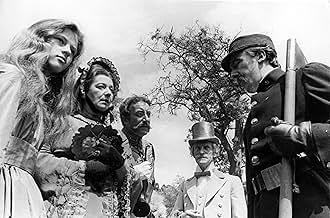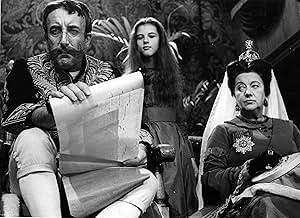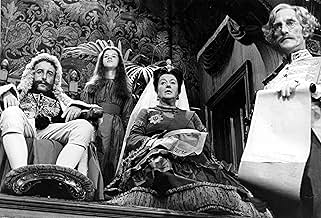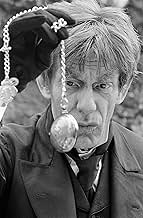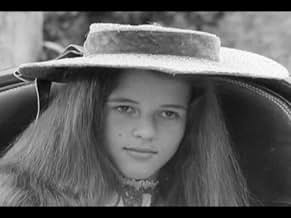IMDb-BEWERTUNG
6,7/10
1098
IHRE BEWERTUNG
Füge eine Handlung in deiner Sprache hinzuA girl named Alice falls down a rabbit-hole and wanders into the strange Wonderland.A girl named Alice falls down a rabbit-hole and wanders into the strange Wonderland.A girl named Alice falls down a rabbit-hole and wanders into the strange Wonderland.
- Regie
- Drehbuch
- Hauptbesetzung
Jo Maxwell Muller
- Alice's Sister
- (as Jo Maxwell-Muller)
Michael Redgrave
- Caterpillar
- (as Sir Michael Redgrave)
Anthony Trent
- Fish Footman
- (as Tony Trent)
- …
Wilfrid Lawson
- Dormouse
- (as Wilfred Lawson)
Empfohlene Bewertungen
First time I saw this was on December 28th 1966 which was its first broadcast on BBC1, the next time was exactly 42 years later on a pristine BFI DVD. I was worried my childhood memories might be shattered by discovering it was simply a trippy '60's cop-out, but I needn't have been. Sure, it's a product of its time same as everything is, but it was and remains a unique filming of the classic tale by Lewis Carroll and imho the best version made so far.
Young Alice is transported by dream one sunny summer day to Wonderland where many adventures befall her. Whether Carroll was attracted or not to little girls ("I like all children, except boys") and whether that explains why his diaries had some ripped out pages at key moments is something we'll never know for sure now - I think he was merely a repressed idealist but he created a timeless story for children of all ages. His 90 page painstakingly hand written original edition which he gave to Alice in 1864 as "a Christmas gift to a dear child in memory of a summer day" is currently online from the British Museum and well worth a read.
Jonathan Miller's erudite sharp focus black and white production assumed that it was really meant for satirical adults, however it still managed to impress this particular 7 year old and especially his 5 year old wife to be and their counterparts 42 years later. Favourite bits: Michael Redgrave as the Caterpillar and John Geilgud as the Mock Turtle; Alice's walk with Duchess Leo McKern down the path through the woods followed by the camera crew weaving in and out of the trees and forward and backward; almost every scene has something of note though. Maybe I could have done with a bit more of Ravi Shankar's exceptional tunes but no worries. It's a pity John Bird's and Peter Sellers' post Goon Show improvisations were left in - it's no good Miller saying it was in the spirit of Carroll when their obvious inspiration was Spike Milligan, just one eg from 1954's Dreaded Batter Pudding Hurler Of Bexhill On Sea: "Suddenly! Nothing happened! But it happened suddenly mark you!" And I still wonder how much the production influenced the Beatles with their image for 1967? Apparently the finished film was considered too long by the BBC and 30 minutes were chopped off. Off with their heads - all those potential Pinteresque moments lost!
This is something to treasure: an arty BBC film that was genuinely arty, entertaining and still eminently watchable generations later. It almost managed to capture the illusive illusionary qualities of dreams and those seemingly beautifully languid sunny days of the '60's both 19th and 20th century.
Young Alice is transported by dream one sunny summer day to Wonderland where many adventures befall her. Whether Carroll was attracted or not to little girls ("I like all children, except boys") and whether that explains why his diaries had some ripped out pages at key moments is something we'll never know for sure now - I think he was merely a repressed idealist but he created a timeless story for children of all ages. His 90 page painstakingly hand written original edition which he gave to Alice in 1864 as "a Christmas gift to a dear child in memory of a summer day" is currently online from the British Museum and well worth a read.
Jonathan Miller's erudite sharp focus black and white production assumed that it was really meant for satirical adults, however it still managed to impress this particular 7 year old and especially his 5 year old wife to be and their counterparts 42 years later. Favourite bits: Michael Redgrave as the Caterpillar and John Geilgud as the Mock Turtle; Alice's walk with Duchess Leo McKern down the path through the woods followed by the camera crew weaving in and out of the trees and forward and backward; almost every scene has something of note though. Maybe I could have done with a bit more of Ravi Shankar's exceptional tunes but no worries. It's a pity John Bird's and Peter Sellers' post Goon Show improvisations were left in - it's no good Miller saying it was in the spirit of Carroll when their obvious inspiration was Spike Milligan, just one eg from 1954's Dreaded Batter Pudding Hurler Of Bexhill On Sea: "Suddenly! Nothing happened! But it happened suddenly mark you!" And I still wonder how much the production influenced the Beatles with their image for 1967? Apparently the finished film was considered too long by the BBC and 30 minutes were chopped off. Off with their heads - all those potential Pinteresque moments lost!
This is something to treasure: an arty BBC film that was genuinely arty, entertaining and still eminently watchable generations later. It almost managed to capture the illusive illusionary qualities of dreams and those seemingly beautifully languid sunny days of the '60's both 19th and 20th century.
Probably will remain in my top 3 Alice in Wonderland film adaptations (it only covers the first book), just below Svankmajer's wonderfully surreal stop-motion version, titled Alice, and I'm somewhat ambivalent about whether I prefer the Disney version or not-it's nicely colored and the characters are more similar to the drawings In Carroll's book, but it has the goofiness of a Disney film, of course. This adaptation is quite faithful to the original book, though a few scenarios might have been removed for time or were altered in some way, but most of the dialogue remains the same.
I was expecting it to feel more like a big studio production, and while the production values were quite good, it's not reminiscent of a Hollywood film or the British equivalent. It has the aura of a B&W art film-and the girl playing Alice (makes me think of a French New Wave heroine), who never smiles, often scowls, is rather sullen, often avoids eye contact or talks while not even looking at the character she's speaking to, and is clearly older than 7 (I believe that was the stated age of Alice in the book). Though she's a bit sassy in the book and not a push over or anything, her behavior seems altered quite a bit based off my, admittedly somewhat time-eroded, memories of Alice and Wonderland. The other change is, while the film is quite faithful in terms of the scenes adapted, the actors are all humans with no attempts to dress them up as the curious assortment of talking animals, odd creatures, and flat card-like men and women found in the book.
The choice of sitar music, with occasional accompaniment, by Ravi Shankar (and someone else I hadn't heard of on oboe) was an interesting and surprisingly fitting choice. I always imagined Canterbury prog or some old folk music with flutes.
In some sense I think it has a more dream-like continuity than the book, because the whimsical passages of Carroll lend's the novel a more structured and deliberate quality, compared to the way the scenes flow and our edited in this version.
I was expecting it to feel more like a big studio production, and while the production values were quite good, it's not reminiscent of a Hollywood film or the British equivalent. It has the aura of a B&W art film-and the girl playing Alice (makes me think of a French New Wave heroine), who never smiles, often scowls, is rather sullen, often avoids eye contact or talks while not even looking at the character she's speaking to, and is clearly older than 7 (I believe that was the stated age of Alice in the book). Though she's a bit sassy in the book and not a push over or anything, her behavior seems altered quite a bit based off my, admittedly somewhat time-eroded, memories of Alice and Wonderland. The other change is, while the film is quite faithful in terms of the scenes adapted, the actors are all humans with no attempts to dress them up as the curious assortment of talking animals, odd creatures, and flat card-like men and women found in the book.
The choice of sitar music, with occasional accompaniment, by Ravi Shankar (and someone else I hadn't heard of on oboe) was an interesting and surprisingly fitting choice. I always imagined Canterbury prog or some old folk music with flutes.
In some sense I think it has a more dream-like continuity than the book, because the whimsical passages of Carroll lend's the novel a more structured and deliberate quality, compared to the way the scenes flow and our edited in this version.
"Who am I?" asks a shabbily dressed, scruffy-haired incarnation of Lewis Carroll's immemorial little girl lost. Of course, the answer's come in various forms ever since such cinematic endeavors as Cecil Hepworth's "Alice in Wonderland," made in 1903 (at 12 minutes, the longest British film of the day; Cecil, you'll remember, two years later made the world's first "dog star" with his monumentally successful "Rescued by Rover," which was shown so many times that the celluloid literally deteriorated, forcing the filmmakers to completely "re-produce" it two more times; his "Alice in Wonderland," unfortunately, did not boast such a success, and thus all we have today is something that looks as though it tumbled down the rabbit hole one too many times). But enough of this sluice at the bottom of the March Hare's treacle well, eh?
Made for the BBC's The Wednesday Play television series, Jonathan Miller's take on the subject matter is, as is traditionally the case, a unique one. With a budget approximating nothing more than his usual "taped stage plays" for which he previously gained great renown (think preter-PBS), Miller decided to illustrate what Alice would have gone through had all of her nonsensical dreams been steeped in the quotidian reality of her ordinary life. There are no talking birds, no storytelling mock turtles, no dormice living in teacups. In fact, short of a crude cut-out superimposition of a very ordinary looking "Cheshire cat" flying in the sky (a la the Teletubbies' eerily omniscient baby in the sun), there's really no special effects or anything that would evince this one of being the least bit chimerical
that is, unless you know the story of Alice in Wonderland already. Ostensibly, what Miller is doing here is showing us the curious, towheaded girl's "adventures" set in a world where people merely sound like birds and look like supine caterpillars sitting loftily back in their Victorian chairs and wondering aloud, "Who are you?" Imagine Wizard of Oz, but without all the costumes, flying monkeys, and mercurial trees pulling at the heroine's hair.
Suddenly, we along with Alice find ourselves in a land where we were already (that is, of course, if we were a haughty 11-year-old girl wandering lackadaisically through our castellated house in the late 19th century). What we see is the "reality" of the dreamworld of Alice's waking life.
And this is exactly what Miller captures in this version of the epic "children's" tale for stoners and mathematicians. In fact, the only real sense of "dreamland" we can extract from Miller's vision is a kind of proto-Gilliam realm of canted camera angles and unsettling juxtapositions of close-up faces in deep-focus environments (think Brazil or particularly Fear & Loathing in Las Vegas, which clearly owes both its visual and aural style to Mr. Miller). Truthfully, after watching this late 60's stark, black-and-white opus (if ever so disjointed and flawed), one would have to assume that Terry Gilliam took much of his artistic sensibility from what is definitely far more than a simple made-for-TV broadcast.
With a quadrille of British mainstaysPeter Cook as the Mad Hatter, Sir John Gielgud as the Mock Turtle, Alan Bennett as the Mouse, an uncredited Eric Idle, and the King of Hearts himself, Peter SellersJonathan Miller, with lilting, ethereal score by Ravi Shankar, does what no other director has done to date with this timeless urtext: he shows us what would have happened had Alice stayed awake during her infamous tour through dreamland.
PS: If this one doesn't do it for you, try out Czech filmmaker Jan Svankmajer's nightmarish Alice (1988), which must be the most haunting adaptation of Alice's adventures yet put on celluloid.
Made for the BBC's The Wednesday Play television series, Jonathan Miller's take on the subject matter is, as is traditionally the case, a unique one. With a budget approximating nothing more than his usual "taped stage plays" for which he previously gained great renown (think preter-PBS), Miller decided to illustrate what Alice would have gone through had all of her nonsensical dreams been steeped in the quotidian reality of her ordinary life. There are no talking birds, no storytelling mock turtles, no dormice living in teacups. In fact, short of a crude cut-out superimposition of a very ordinary looking "Cheshire cat" flying in the sky (a la the Teletubbies' eerily omniscient baby in the sun), there's really no special effects or anything that would evince this one of being the least bit chimerical
that is, unless you know the story of Alice in Wonderland already. Ostensibly, what Miller is doing here is showing us the curious, towheaded girl's "adventures" set in a world where people merely sound like birds and look like supine caterpillars sitting loftily back in their Victorian chairs and wondering aloud, "Who are you?" Imagine Wizard of Oz, but without all the costumes, flying monkeys, and mercurial trees pulling at the heroine's hair.
Suddenly, we along with Alice find ourselves in a land where we were already (that is, of course, if we were a haughty 11-year-old girl wandering lackadaisically through our castellated house in the late 19th century). What we see is the "reality" of the dreamworld of Alice's waking life.
And this is exactly what Miller captures in this version of the epic "children's" tale for stoners and mathematicians. In fact, the only real sense of "dreamland" we can extract from Miller's vision is a kind of proto-Gilliam realm of canted camera angles and unsettling juxtapositions of close-up faces in deep-focus environments (think Brazil or particularly Fear & Loathing in Las Vegas, which clearly owes both its visual and aural style to Mr. Miller). Truthfully, after watching this late 60's stark, black-and-white opus (if ever so disjointed and flawed), one would have to assume that Terry Gilliam took much of his artistic sensibility from what is definitely far more than a simple made-for-TV broadcast.
With a quadrille of British mainstaysPeter Cook as the Mad Hatter, Sir John Gielgud as the Mock Turtle, Alan Bennett as the Mouse, an uncredited Eric Idle, and the King of Hearts himself, Peter SellersJonathan Miller, with lilting, ethereal score by Ravi Shankar, does what no other director has done to date with this timeless urtext: he shows us what would have happened had Alice stayed awake during her infamous tour through dreamland.
PS: If this one doesn't do it for you, try out Czech filmmaker Jan Svankmajer's nightmarish Alice (1988), which must be the most haunting adaptation of Alice's adventures yet put on celluloid.
This is an experimental TV-movie from the BBC's "Wednesday Play" anthology. That series was always willing to risk trying something different, and this ambitious, low-budget "Alice" is certainly different. I don't exactly *enjoy* this film, but it's certainly fascinating.
I appreciate it as an experiment in what television could do. I admire the cast of iconic and talented Britons who wouldn't normally coincide in the same project: Peter Sellers, John Gielgud, Leo McKern (in drag as the Duchess), Michael Redgrave, Peter Cook, Wilfrid Brambell, Alan Bennett, Malcolm Muggeridge, etc.
I also admire the creativity it took to imagine this quintessentially British tale accompanied by Ravi Shankar music.
Some viewers may find the film too creepy and surreal, but the original book is pretty disturbing to begin with. This film is fairly incoherent, but then so is the book, which follows the ever-shifting logic of a dream.
The biggest problem (aside from pacing that now seems too leisurely) is that Miller's production assumes you already know what's going on. For instance, it assumes you know that the two men dressed as... um... men are actually the Gryphon and the Mock Turtle.
In other words, this is an "Alice" for people who are already overdosed on adaptations of "Alice," and who might appreciate a weirdly different take on the familiar story. Or to narrow that audience a bit, people age 12 and up who might appreciate a different take on the story.
I appreciate it as an experiment in what television could do. I admire the cast of iconic and talented Britons who wouldn't normally coincide in the same project: Peter Sellers, John Gielgud, Leo McKern (in drag as the Duchess), Michael Redgrave, Peter Cook, Wilfrid Brambell, Alan Bennett, Malcolm Muggeridge, etc.
I also admire the creativity it took to imagine this quintessentially British tale accompanied by Ravi Shankar music.
Some viewers may find the film too creepy and surreal, but the original book is pretty disturbing to begin with. This film is fairly incoherent, but then so is the book, which follows the ever-shifting logic of a dream.
The biggest problem (aside from pacing that now seems too leisurely) is that Miller's production assumes you already know what's going on. For instance, it assumes you know that the two men dressed as... um... men are actually the Gryphon and the Mock Turtle.
In other words, this is an "Alice" for people who are already overdosed on adaptations of "Alice," and who might appreciate a weirdly different take on the familiar story. Or to narrow that audience a bit, people age 12 and up who might appreciate a different take on the story.
A fascinatingly, surreal and psychedelic version of the Alice in Wonderland story. Shot in a Gothic black and white style, the cinematography is very well done and still holds up 50 years later.
The cast is very very good, particularly Anne-Marie Malik in her one and only role of Alice. She's petulant and outspoken, but also very reserved and examining. She's adorable, and her delivery of lines add to the dreamlike quality of the movie. She makes the whole movie worth watching.
Filmed as a TV play it's surprisingly well made, thank the BBC for that, they do some exceptional work.
Jonathan Miller's Alice in Wonderland is worth viewing if you can find it.
The cast is very very good, particularly Anne-Marie Malik in her one and only role of Alice. She's petulant and outspoken, but also very reserved and examining. She's adorable, and her delivery of lines add to the dreamlike quality of the movie. She makes the whole movie worth watching.
Filmed as a TV play it's surprisingly well made, thank the BBC for that, they do some exceptional work.
Jonathan Miller's Alice in Wonderland is worth viewing if you can find it.
Wusstest du schon
- WissenswertesMost of this movie was shot with a 9mm camera lens.
- PatzerIn the scenes with the Mock Turtle, his legs are crossed in all the long shots, but in close-up shots, his legs are in a completely different position; without there being enough time to have changed them from one shot and another.
- Crazy CreditsThe end credits use Lewis Carroll's original ink drawings from his handwritten manuscript (called 'Alice's Adventures Under Ground') now in the British Library.
- VerbindungenFeatured in The Worlds of Fantasy: The Child Within (2008)
Top-Auswahl
Melde dich zum Bewerten an und greife auf die Watchlist für personalisierte Empfehlungen zu.
Details
- Erscheinungsdatum
- Herkunftsland
- Offizieller Standort
- Sprache
- Auch bekannt als
- Alice Harikalar Diyarında
- Drehorte
- Produktionsfirma
- Weitere beteiligte Unternehmen bei IMDbPro anzeigen
- Laufzeit1 Stunde 12 Minuten
- Farbe
- Sound-Mix
- Seitenverhältnis
- 1.33 : 1
Zu dieser Seite beitragen
Bearbeitung vorschlagen oder fehlenden Inhalt hinzufügen

Oberste Lücke
By what name was Alice in Wonderland (1966) officially released in Canada in English?
Antwort



